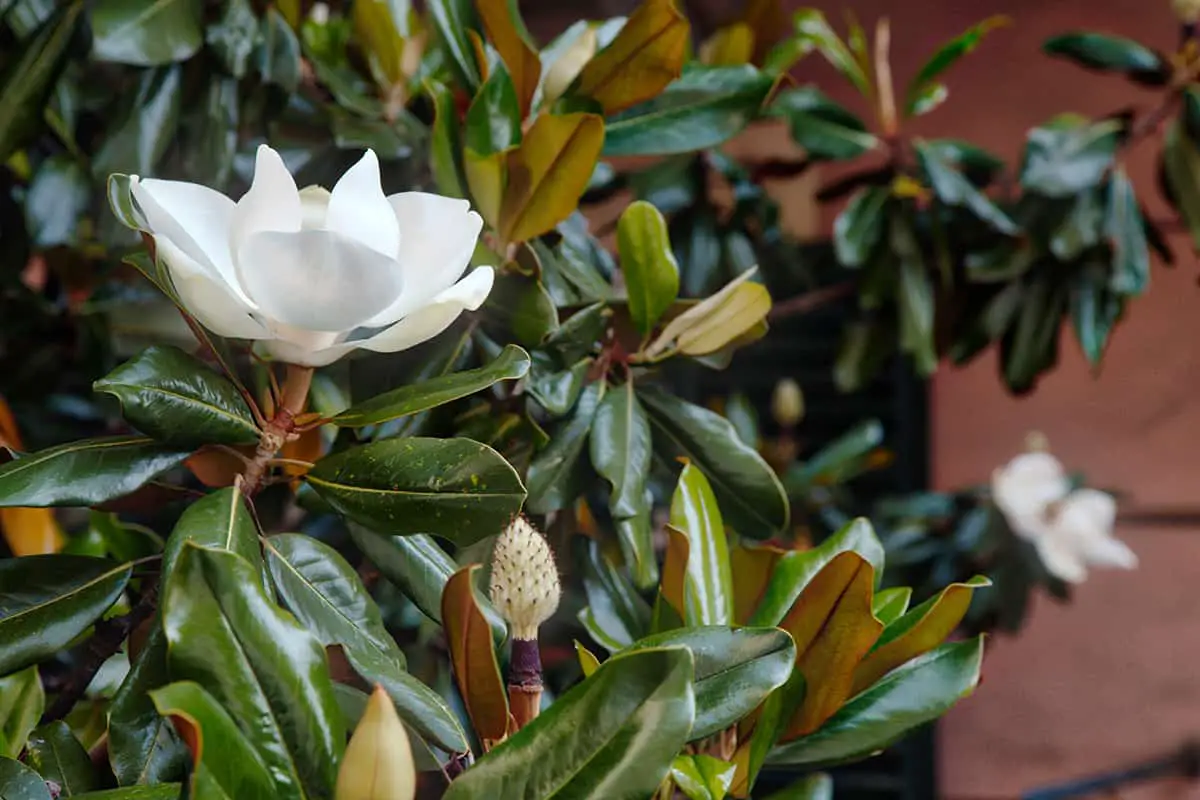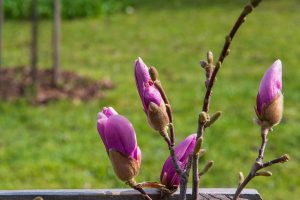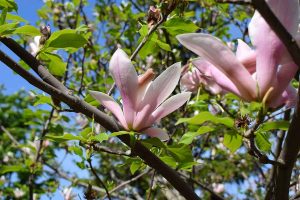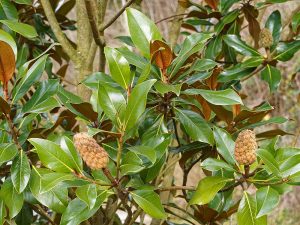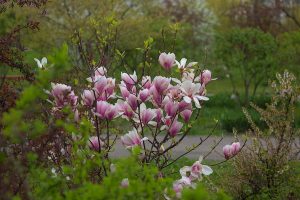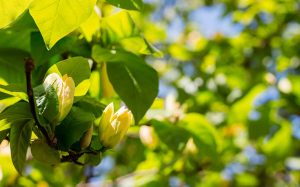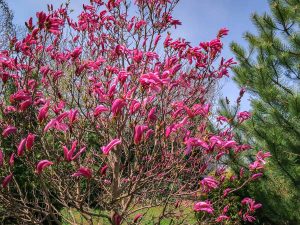The Little Gem Magnolia is a classic beauty, with thick white flowers and glossy dark green foliage, it is a dwarf variety of the iconic Southern Magnolia. It works well as an alternative to the Southern Magnolia for more compact gardens, either as a specimen tree or grown in a row to create a privacy border.
The Little Gem Magnolia has a long flowering period, blooming from mid to late spring right through to the middle of summer. The flowers closely resemble those of the larger Southern Magnolia, taking on a cup shape and measuring around 4 inches across. The foliage of this tree is dark green and leathery, with a smooth, glossy appearance on the surface.
As an evergreen variety of magnolia, the leaves offer beauty all year round. They typically measure 5 inches long and have a slender elliptical shape.
- Botanical name: Magnolia grandiflora ‘Little Gem’
- Common names: Little Gem Magnolia, Evergreen Magnolia ‘Little Gem’
- Plant family: Magnoliaceae
- USDA hardiness zone: 7- 9
- Mature height: Up to 20 feet
- Mature spread: Up to 10 feet
Table of Contents
Varieties of Little Gem Magnolia
Little Gem Magnolia is a variety of Southern Magnolia. Other varieties of Southern Magnolia include:
Exmouth Magnolia (Magnolia grandiflora ‘Exmouth’)
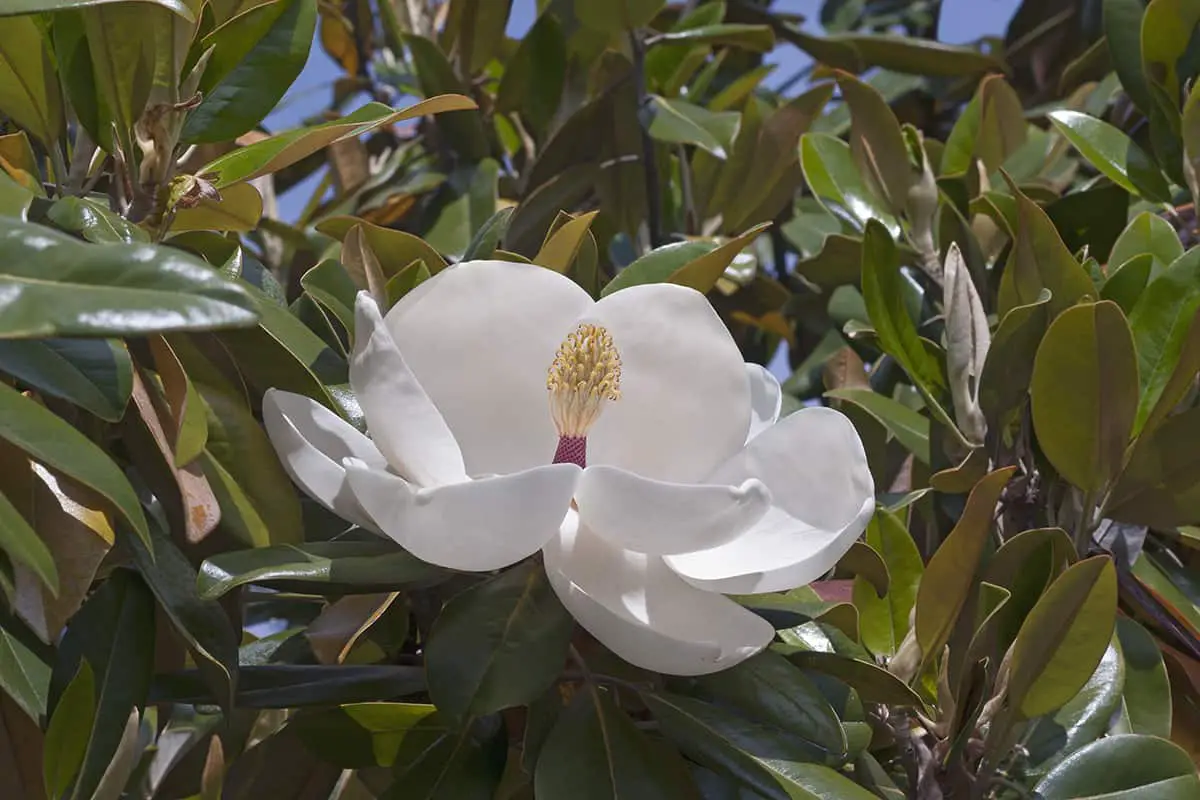
Like the Little Gem Magnolia, the Exmouth Magnolia is suited for growing in USDA hardiness zones 7 to 9. It is a medium-sized tree, growing to typical heights of between 30 and 40 feet, with a similar-sized spread. While the Little Gem Magnolia can begin to flower from just a few years of age, the Exmouth Magnolia will not start blooming until it is around 10 years old.
The flowers are magnificent, and certainly worth the wait. They bloom in the middle of spring and will continue to flower all summer long and even into fall. The flowers are huge at 10 inches across, and they extend from the tips of the tree’s stems. The bowl-shaped flowers are heavily scented and are a shade of ivory.
They open out during the morning, and will then close up for several days before blooming again and repeating the process. The evergreen foliage of this tree is also very attractive, with each leaf typically measuring around 10 inches long. The upper surface of the leaves is glossy dark green, while the undersides are brown and furry. The height and far-reaching crown of this tree make it well suited to use as a shade tree, but it also makes an appealing specimen tree.
Kay Parris Magnolia (Magnolia grandiflora ‘Kay Parris’)
The Kay Parris Magnolia is a dwarf variety of Southern Magnolia, like the Little Gem Magnolia. It grows to mature heights of between 15 and 20 feet, with a spread of between 8 and 10 feet. This variety is widely considered to be one of the best types of evergreen magnolia trees, due to its attractive foliage and enormous flowers.
The flowers arrive at the tips of branches in late spring, and they will continue to bloom right through to fall. They are bowl-shaped and cream-colored, spanning between 8 and 10 inches in diameter. The huge size of the flowers compared with the small stature of the tree make it incredibly dramatic.
After blooming, the flowers will develop into fruits that contain bright red seeds, which are released and held pendulously when the fruit’s outer pod splits open. The foliage of this tree is also quite special and is favored by florists in dried arrangements. The leaves are dark green and leathery, and they have an unusual wavy edge. The tree is marginally more hardy than the Little Gem Magnolia, able to be grown down to USDA hardiness zone 6.
How to Care for your Little Gem Magnolia
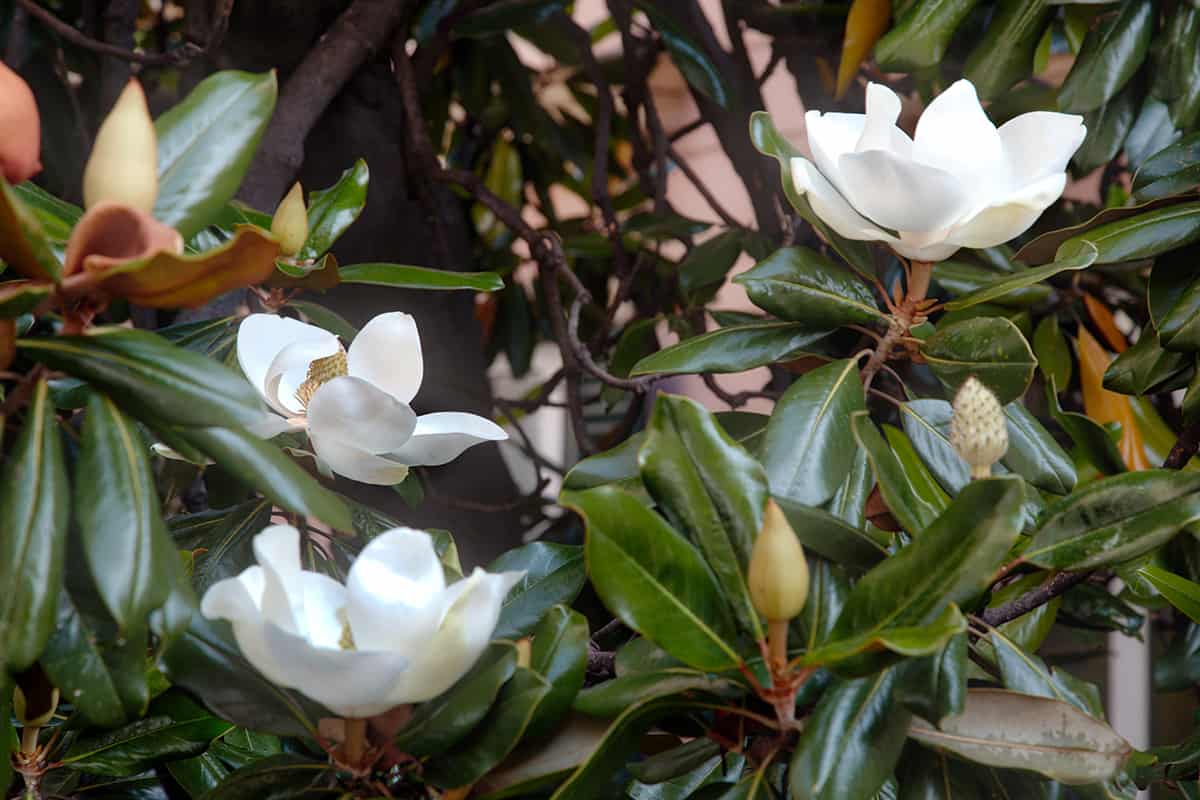
Little Gem Magnolia trees are fairly low maintenance, but you’ll want to ensure that they are grown in the correct environment and conditions to help them thrive.
Light
The Little Gem Magnolia will adapt to a variety of lighting conditions, but it will perform best in full sun. Natural light is essential to help the tree bloom, so if you want a profusion of flowers then more light is better.
This tree can tolerate moderate levels of shade, but too much shade will negatively affect its ability to bloom. If you are growing this plant to enjoy an abundance of flowers, it should be planted in a position that enjoys plenty of light throughout the day.
Soil
The Little Gem Magnolia needs to be grown in soil which drains well since it requires a high level of moisture, yet will not thrive in wet conditions. A well-draining soil will encourage excess water to drain away from the roots in order to prevent root rot and limit the likelihood of the fungal disease being a problem.
The Little Gem Magnolia, like most magnolias, will perform best in acidic soil. You can amend alkaline soil to make it more acidic to encourage better growth by adding sulfur, compost, lemon juice, or vinegar, but the Little Gem Magnolia will adapt to alkaline soil. The soil where this tree is growing should also be rich in organic material, which will help to provide nutrients as well as improve moisture retention.
Getting a good balance between moisture-retentive and well-draining soil will help the tree to thrive, allowing it to absorb the food and drink it needs while also eliminating the chance of the soil becoming waterlogged. The most important thing for magnolia trees is that their soil is able to remain moist without being overly wet.
Water
The Little Gem Magnolia is a thirsty plant that will reward you with plentiful flowers if you keep its soil moist. When the tree is first planted, it will need to be watered every day for several weeks to help it settle in, though of course, this won’t be necessary if the region is experiencing daily rainfall.
After a few weeks, you can reduce the frequency of watering down to twice weekly, but aim to ensure the soil remains moist throughout every season until the tree is mature. Once mature, the Little Gem Magnolia will develop some level of drought tolerance and can survive predominantly on rainwater, though supplementary watering through dry months will benefit the tree. The Little Gem
Magnolia is a low-maintenance tree once mature, however, if you want to encourage a greater amount of flowers, it would be wise to maintain moist soil indefinitely. The level of light and heat the tree receives will have a bearing on the amount of moisture it needs to thrive.
In hotter climates where the tree is in full sun, more water will be needed, while Little Gem Magnolia trees grown in shadier or cooler conditions will not require as much water. If you are finding that the soil is drying out too quickly, you can apply mulch over the top of the soil to help reduce moisture evaporation and help to keep the soil moist for longer.
Temperature
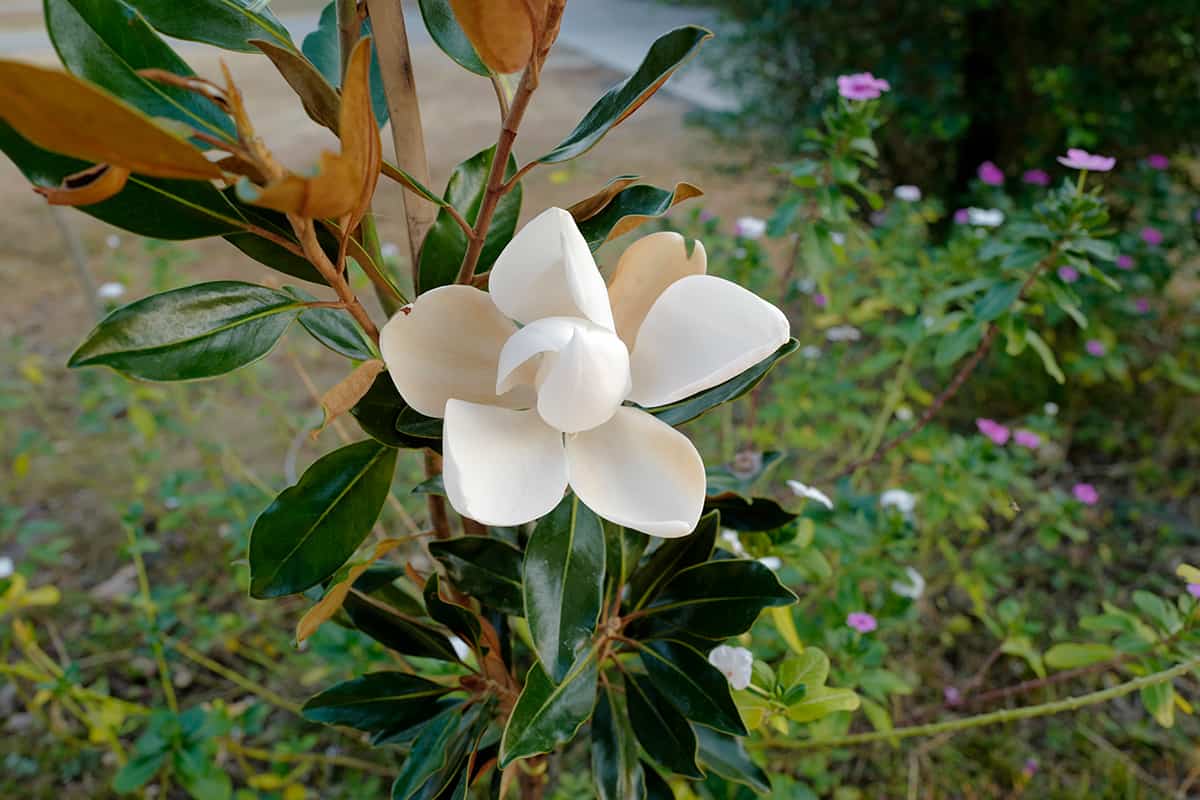
Like other Southern Magnolias, the Little Gem Magnolia prefers more temperate climates and is not very hardy. It is suitable for growing in USDA hardiness zones 7 to 9.
Fertilizer
The Little Gem Magnolia can benefit from a slow-release fertilizer, applied in early spring and late fall. Fertilizers specifically formulated for magnolias will work well, or use one with a higher ratio of nitrogen. Organic compost applied on top of the soil can also be used as an alternative to fertilizer.
Pruning
This tree does not need to be pruned and will take a narrow column shape without any intervention. As it is such a compact tree, it is unlikely that it will need to be trimmed to contain its size, however, if you must prune it, you should do so cautiously.
Heavy pruning can send the Little Gem Magnolia tree into shock, which can stunt its growth and prevent flowering. Dead, damaged, or diseased growth can be removed as it appears.
Additional Care
Little Gem Magnolia trees are quite low maintenance in terms of their care. They can survive with minimal intervention, as long as they are receiving a good level of water from rainfall. They are not tolerant of salt so they should not be grown in coastal regions, and they can also be negatively affected by pollution.
Little Gem Magnolia FAQs
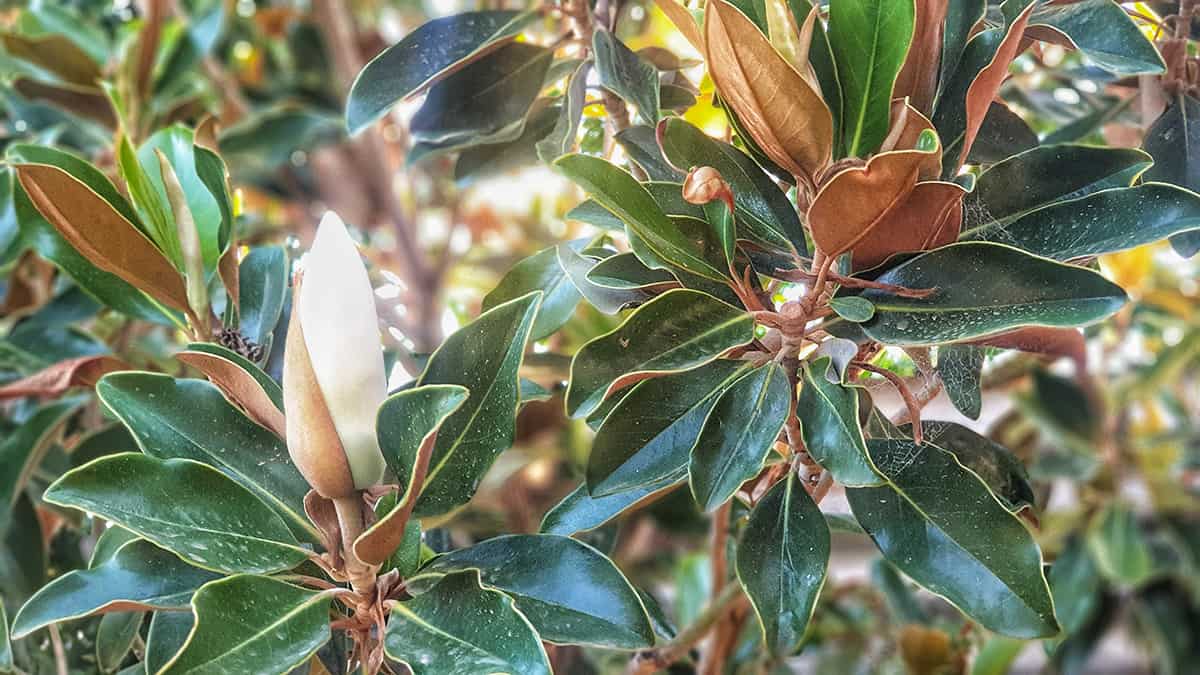
Are Little Gem Magnolias easy to grow?
Little Gem Magnolias are fast growing and they thrive easily in climates that experience plenty of rain and mild temperatures. They are low-maintenance trees, especially when mature, however, they can be messy to clean up when the fruits drop to the ground.
Are Little Gem Magnolias resistant to pests?
This tree is rarely the victim of pest infestations, though they are possible. The pest which is most likely to affect the Little Gem Magnolia is scale. Diseases are also rare for this tree, though it can suffer from fungal diseases such as honey fungus and coral spot.
